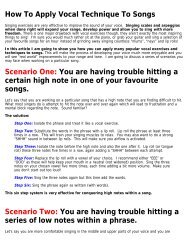What does breathing and posture have to do with the way you sing?
What does breathing and posture have to do with the way you sing?
What does breathing and posture have to do with the way you sing?
Create successful ePaper yourself
Turn your PDF publications into a flip-book with our unique Google optimized e-Paper software.
This expansion <strong>and</strong> contraction of <strong>the</strong> rib cage is termed wall <strong>breathing</strong>.<br />
Do this….<br />
Place <strong>you</strong>r h<strong>and</strong>s under <strong>the</strong> bot<strong>to</strong>m of <strong>you</strong>r ribs. Experiment by taking a couple of normal<br />
breaths, <strong>and</strong> <strong>the</strong>n larger breaths. During <strong>the</strong> larger breaths <strong>you</strong> should feel <strong>the</strong> lower ribs move<br />
out slightly.<br />
So what <strong>breathing</strong> co-ordination is <strong>the</strong> best for <strong>sing</strong>ing<br />
1. 4. A combination of floor <strong>and</strong> wall <strong>breathing</strong>.<br />
Do this….<br />
Sit on a chair or on <strong>the</strong> floor. Pull <strong>you</strong>r knees up <strong>to</strong> <strong>you</strong>r chest <strong>and</strong> wrap <strong>you</strong>r arms around <strong>you</strong>r<br />
legs for support. Take a couple of normal breaths. Focus <strong>the</strong> air <strong>to</strong> <strong>you</strong>r pelvic area making<br />
sure that <strong>you</strong> relax <strong>you</strong>r abs. As <strong>the</strong> air fills up from <strong>the</strong> “floor” notice <strong>you</strong>r lower ribs engage<br />
<strong>and</strong> exp<strong>and</strong>. You should also feel <strong>the</strong> muscles in <strong>you</strong>r lower back stretch as well. Now take a<br />
more energized breath. As <strong>you</strong> exhale make a “sh” sound. Repeat this process 3 times.<br />
Return <strong>to</strong> a st<strong>and</strong>ing position. A<strong>do</strong>pt <strong>you</strong>r correct <strong>posture</strong> <strong>and</strong> try <strong>to</strong> emulate <strong>the</strong> combination breath while<br />
st<strong>and</strong>ing. It is important <strong>to</strong> maintain a high sternum on <strong>the</strong> exhale. Collap<strong>sing</strong> will force <strong>the</strong> air out.<br />
Controlling <strong>the</strong> breath is <strong>the</strong> key <strong>to</strong> skilled <strong>breathing</strong>.<br />
How did <strong>you</strong> go<br />
If <strong>you</strong> are having trouble, go back <strong>and</strong> repeat <strong>the</strong> o<strong>the</strong>r exercises. Remember muscles <strong>have</strong> memory <strong>and</strong> if<br />
repeated enough <strong>the</strong> co-ordination will become au<strong>to</strong>matic. You <strong>do</strong>n’t want <strong>to</strong> be thinking “what are my abs<br />
<strong>do</strong>ing right now” in <strong>the</strong> middle of a performance!<br />
Now is a great time <strong>to</strong> talk about breath inhalation. Have <strong>you</strong> taken notice of how a <strong>sing</strong>er brea<strong>the</strong>s<br />
Hearing <strong>the</strong> breath can destroy a musical phrase. Some <strong>sing</strong>ers use an audible breath <strong>to</strong> add an effect <strong>to</strong><br />
<strong>the</strong>ir sound. That is fine if it is used for style purposes, but generally it is pretty annoying.<br />
Large audible breaths tend <strong>to</strong> activate “ceiling” <strong>breathing</strong>. That breathy sound that <strong>you</strong> hear is air rushing<br />
through <strong>you</strong>r vocal folds. I will discuss <strong>the</strong> vocal folds in more depth in <strong>the</strong> next lesson. This rush of air<br />
puts <strong>the</strong> folds under pressure. Too much pressure <strong>and</strong> <strong>the</strong> use of unnecessary muscles in <strong>the</strong> throat will<br />
create tension. Tension is <strong>the</strong> <strong>sing</strong>er’s biggest enemy.<br />
Learn <strong>to</strong> take a silent breath when <strong>sing</strong>ing. Brea<strong>the</strong> in a relaxed <strong>and</strong> open manner. This will:<br />
1. Feel better<br />
2. Sound better<br />
Do this….<br />
Take 3 large audible breaths. Notice <strong>the</strong> feeling <strong>and</strong> <strong>the</strong> sound.<br />
Now take 3 natural silent breaths. Notice <strong>the</strong> sense of ease <strong>and</strong> openness.<br />
This time inhale over a 5 second period. You can choose <strong>to</strong> brea<strong>the</strong> through <strong>the</strong> nose or mouth<br />
or both. It <strong><strong>do</strong>es</strong>n’t matter which option <strong>you</strong> choose, just make sure it is silent <strong>and</strong> free. Be<br />
aware that <strong>you</strong> are “filling up” from <strong>the</strong> floor first, <strong>and</strong> <strong>the</strong>n <strong>you</strong>r ribs will engage.<br />
The Exhale<br />
You can control <strong>the</strong> amount of air <strong>you</strong> exhale while <strong>sing</strong>ing. It is commonly called “breath control”.



